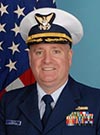
The Council is welcoming a familiar face to its staff this spring. Former U.S. Coast Guard Commander Joseph T. Lally has stepped into the position of director of programs.
Lally served as commanding officer of the Marine Safety Unit Valdez from June 2014 through July 2017. One of the duties of that position is to represent the Coast Guard as a non-voting, ex-officio member of the Council.
Lally served the Coast Guard for 27 years, most recently as compliance and analysis division chief at the Coast Guard’s headquarters in Washington, D.C., before retiring earlier this year. Over the years, he held a variety of assignments. Lally has an extensive background in oil spill/hazardous substance response and prevention, including federal policy writing, conducting marine inspections and investigations, and leading emergency responses as the federal on-scene coordinator. He worked with agency and industry partners, and non-governmental organizations to enhance marine safety, prevention, preparedness, and response nationwide.

